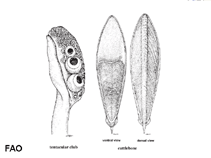Rhombosepion omani (Adam & Rees, 1966)
Oman cuttlefish
Classification / Names Common names | Synonyms | CoL | ITIS | WoRMS
| Sepiida | Sepiidae
Environment: milieu / climate zone / depth range / distribution range Ecologia
; intervalo de profundidade 50 - 210 m (Ref. 1695). Tropical; 27°N - 17°N, 56°E - 73°E (Ref. 1695)
Distribuição Países | Áreas FAO | Ecossistemas | Ocorrências | Introduções
Western Indian Ocean: from Gulf of Oman to western India.
Length at first maturity / Tamanho / Peso / Idade
Maturity: Lm ? range ? - ? cm Max length : 10.0 cm ML macho/indeterminado; (Ref. 1695)
Life cycle and mating behavior Maturidade | Reprodução | Desova | Ovos | Fecundidade | Larvas
Members of the class Cephalopoda are gonochoric. Male and female adults usually die shortly after spawning and brooding, respectively. Mating behavior: Males perform various displays to attract potential females for copulation. During copulation, male grasp the female and inserts the hectocotylus into the female's mantle cavity where fertilization usually occurs. Life cycle: Embryos hatch into planktonic stage and live for some time before they grow larger and take up a benthic existence as adults.
Referência principal
Referências | Coordenador | Colaboradores
Jereb, P. and C.F.E. Roper (eds.). 2005. (Ref. 1695)
Status na Lista Vermelha da IUCN (Ref. 130435)
Segura ou pouco preocupante (LC) ; Date assessed: 15 March 2009
Status no CITES (Ref. 108899)
Not Evaluated
CMS (Ref. 116361)
Not Evaluated
Perigo para os humanos
Uso pelos humanos
| FishSource |
Ferramentas
Mais informação
Idade/Tamanho
Crescimento
Comprimento-peso
Comprimento-comprimento
Morfologia
Larvas
Abundância
Crescimento
Comprimento-peso
Comprimento-comprimento
Morfologia
Larvas
Abundância
Fontes da internet
BHL | BOLD Systems | CISTI | DiscoverLife | FAO(Publication : search) | Fishipedia | GenBank (genoma, nucleotídeo) | GloBI | Gomexsi | Google Books | Google Scholar | Google | PubMed | Árvore da vida | Wikipedia (Ir para, procura) | Registro zoológico
Estimates based on models
Preferred temperature
(Ref. 115969): 20.5 - 23.6, mean 22.5 (based on 18 cells).



